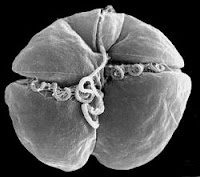 |
| Credit: Florida Fish and Wildlife Research Institute |
Pinellas County Sea Grant Extension Agent
We all remember the Gulf of Mexico beaches of 2005 littered with decaying fish. The fish kill was caused by “red tide” and recent reports of a patchy bloom of Florida Red Tide in southwest Florida from southern Pinellas County through Lee County is causing concern. So what is red tide and what are the impacts to us?
Red tide is the result of a harmful algal bloom (HAB) of a tiny single-celled dinoflagellate algae called Karenia brevis. Red tide in Florida is a natural phenomenon, originating offshore from algae lying dormant as cysts in the sediment. It is unclear what causes the cysts to awaken and multiply. HABs occur under a particular combination of biology, chemistry, and physics.
Many red tides produce toxic chemicals that can affect both marine life and humans. The Florida red tide organism, K. brevis, produces brevetoxins that can affect the central nervous system of fish and other vertebrates, causing these animals to die. Fish can acquire the toxins through direct uptake (planktivorous fish), or by bioaccumulation through the food chain. Often the animals themselves do not exhibit any visible sign of contamination. Predatory fish, birds, marine mammals and humans that eat this fish can become poisoned. Blooms of K. brevis can kill millions of fish and birds in a few days, and blooms can last for weeks.
The red tide toxins can also accumulate in molluscan filter-feeders such as oysters and clams, which can lead to Neurotoxic Shellfish Poisoning in people who consume contaminated shellfish. Red tide also causes respiratory irritation in humans as K. brevis cells release toxins into the air as they are broken down by wave action. For people with severe or chronic respiratory conditions, such as emphysema or asthma, red tide can cause serious illness.
Although the occurrence of a red tide cannot be predicted, scientists can forecast its movement using wind and water current data once a bloom is located. Scientists also monitor the concentration of the red tide organism by collecting water samples routinely and in response to blooms. The information provided by forecasting and monitoring allows citizens to make informed decisions regarding their beach-going activities.
Some precautions that can be taken to avoid disease and/or discomfort due to red tide HABs include:
- Stay away from the water where HAB conditions have been identified or if water is foamy or discolored or contains dead fish.
- Do not eat, use or collect any fish, crabs, shellfish, other life or items from those waters.
- Do not let pets swim in or eat fish from those waters.
- If contact is made with the water, rinse as soon as possible with fresh water.
- If you suffer respiratory discomfort when near the water, moving a short distance away from the shore may alleviate the symptoms. In more severe cases, stay indoors in air-conditioned rooms as much as possible.
Red tides can last as little as a few weeks or longer than a year. The duration of a bloom in nearshore Florida waters depends on physical and biological conditions that influence its growth and persistence, including sunlight, nutrients and salinity, as well as the speed and direction of wind and water currents. HABs can have consequences on human health, the environment, local and regional economies, and can impact natural ecological communities directly and indirectly.
For more information on active red tide events, visit the FWC website and access the resources below. http://www.myfwc.com/research/redtide/events/status/
References-
Rey, Jorge R. 2008. Red Tides. University of Florida, IFAS, EDIS ENY-851 (IN766), http://edis.ifas.ufl.edu/in766.
Staugler, Betty. 2012. Red Tide 101. University of Florida IFAS/ Charlotte County Extension. EAS-010412-002.

No comments:
Post a Comment